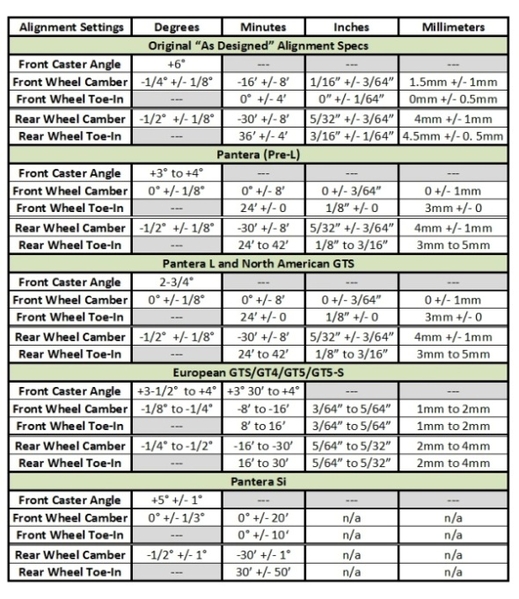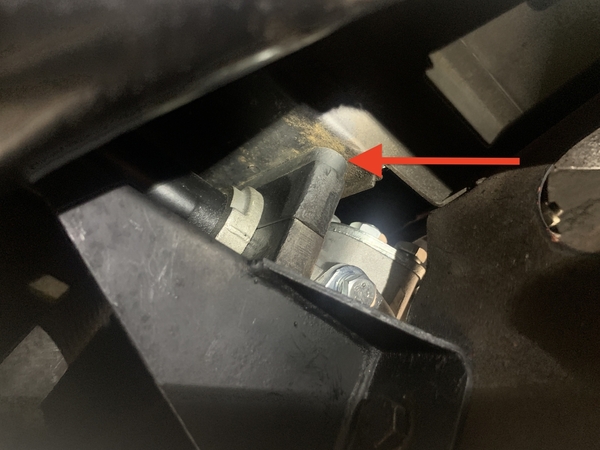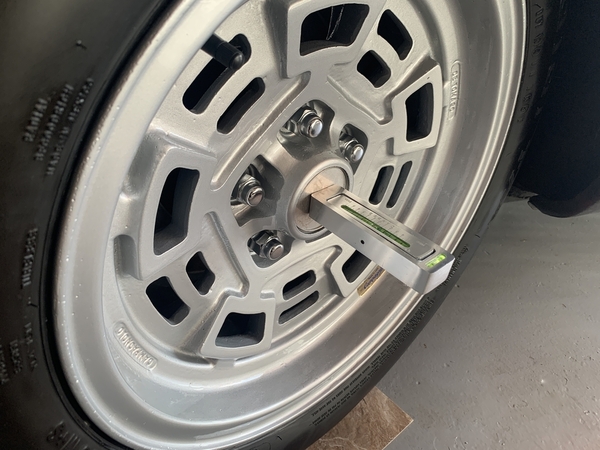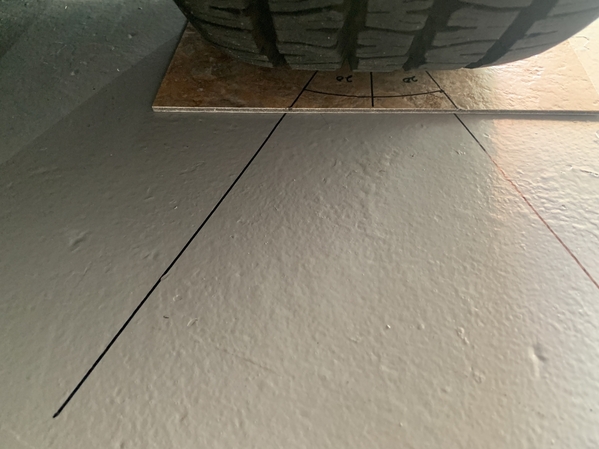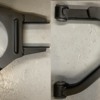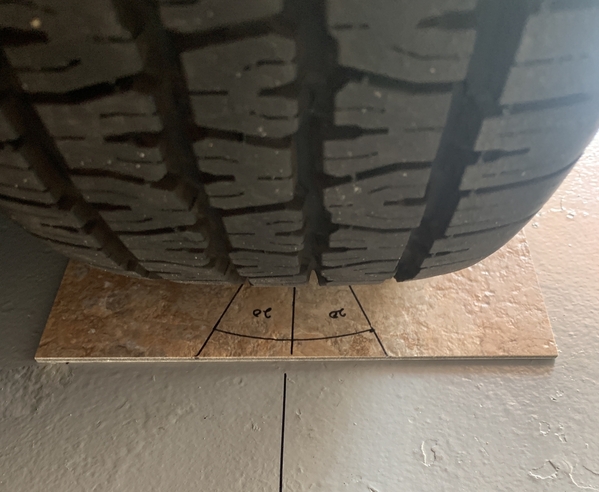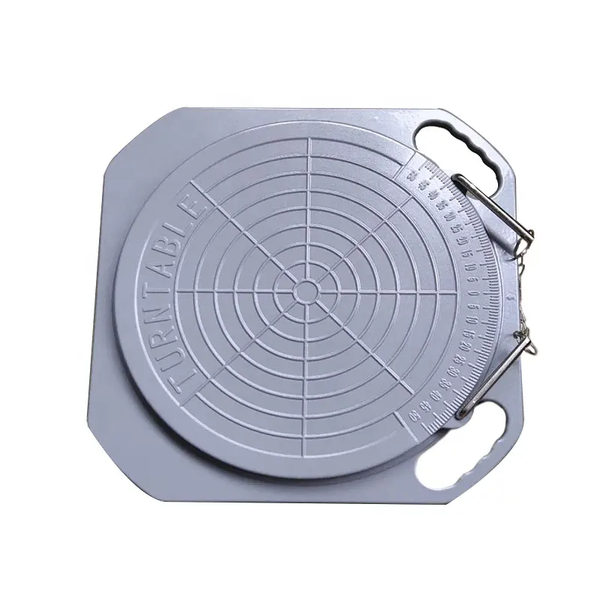The above chart clearly shows the caster settings for our cars. The amount of caster is commonly checked by putting the front wheels on turntables and turning the wheel outward 20 degrees and setting the gauge to zero, then turning the wheel inward to 20 degrees to find actual caster for that wheel. Does the above chart assume that caster is checked with 40 degrees total rotation of the wheel?
Replies sorted oldest to newest
I also need to ask if anyone is checking the caster setting of their car in the garage. If so, how are you doing it?
Steve I used a bubble tool from Longacre. I don't remember if this is the same tool but this is what I used.
https://www.longacreracing.com...%2f-Magnetic-Adapter
You are welcome to borrow mine if you wish. You know how to contact me.
Thanks Tony. I already have a magnetic bubble level. In Longacre’s instructions they are sayings to use a total of 40 degrees rotation (20 to the right and then 20 to the left). Thus, it looks like the chart above is assuming 40 degrees rotation.
From Longacre:
To read CASTER first turn the wheels 20º to the right when setting the RF and to the left when setting LF. If you don't have a set of turn plates you can use the angles machined on the corners of the gauge as a reference. Turn the wheels until the angle is parallel to the side of the car. Rotate the gauge until it is level. Turn the knurled nob in the center until the center caster vial reads 0º. Now turn the wheels back past center to 20º the opposite way - for a total of 40º.
Steve, That's what I did and it seems to work. If I recall correctly I installed as many shims as possible to obtain as much caster as possible. The Pantera is very limited in its adjustment as you probably already know.
Thank you both.
I am getting setup to modify the front upper a-arms in order to get more positive caster and have read the threads on this forum about the process of doing so. I am currently trying to get precise measurements of caster on the car before I cut, bend, and weld my a-arms. I am looking forward to getting better straight line handling and centering of the car on the freeway. I will probably follow this effort with spacers for the steering rack to reduce bump steer. That way I am only making one change at a time.
I just now checked under the car and it already has bump steer shims. I think they are from the factory (the car is #6973). I did not know what they were when I replaced the rack a while back but remember thinking something was different.
Attachments
I was able to measure caster and it came in just under 2 3/4 degrees on both sides. This car is a 1974 and that's the value for it per the chart above. I attached a bubble level to an old wheel center and utilized floor tiles as turn tables. The next step is to modify the upper arms to get more caster.
Attachments
Steve, Ford/DeTomaso began installing bump-steer shims in 1973-up (there's even a part number for them) so those are likely stock parts, given your serial number. I had to make my own for my Sept '72 Pantera.
Different caster gauges use different steering wheel angles for the readings
I completed the modification to the upper front a-arms to get more caster. This modification allows for the addition of a 1/2" shim. The next steps are to reassemble the a-arms, measure the new amount of caster, and test drive the car. I can move shims around to get a little less caster if needed. Electric power steering from SACC should arrive in April.
In the photo below you can see that the top bar was removed by cutting the welds, flattened in a press, and then welded back in place.
Attachments
I think that you are going to want power steering...and you may have this little issue with the tires hitting the fenders, but just when you turn? ![]()
Power steering is already on order. I am hoping to not have tires rubbing the fender but realize that it could be an issue. If it happens then I can reduce the positive caster a little and/or roll the fenders. We will find out shortly.
I had 245-50 x 15s on 8" Campys touch the left front cowl drain pipe (full lock turns & hard braking when autocrossing ). Partially flattened an area about 3" long with a hammer/5 minutes.
Also had the right front tire touch the wiper motor shield in full lock/hard braking turns. Had to modify the shield at one bend to clear. This is with 4-1/2 degrees of caster and no shock spacers. No further physical contact in 15 yrs.
Wiper shield-to-tire contact is so common, Larry Stock at PPC now offers cleaned & painted pre-flattened wiper shields on an exchange basis.
All you need in the front are 225-50-15's. They add to the Italian go-cart concept and you won't have any interferences anywhere.
Probably all that you need for high speed stability is 4-1/2 degrees like Boss has but with the power steering, you can run stock since it will add the stability without the increased caster.
If your feet are too big you may find a little interference to the PS unit. It's really close under there on the clutch side. Driving shoes are a must.
Anything over 11-1/2's, forget about it.
Steve,
As positive caster is increased, the steering arm (spindle arm) moves upward, which effects bump steer. If you have bump steer shims installed, they may have to be removed or thinner shims installed.
John
John,
Good point. The car has not had an issue with bump steer up to this point. Thanks for bringing this to my attention.
Steve
@panteradoug posted:If your feet are too big you may find a little interference to the PS unit. It's really close under there on the clutch side. Driving shoes are a must.
Anything over 11-1/2's, forget about it.
I wear a 12-1/2 running shoe and have zero interference issues with my EZ Electric system.
@panteradoug posted:I think that you are going to want power steering...and you may have this little issue with the tires hitting the fenders, but just when you turn?
The modified upper a-arms are now installed and the ball joints are shimmed all the way to the back. I test drove the car and there is not any tire rub on either side while fully locking the rack and doing a sharp u-turn. You can see the additional 1/2" shim below. I measured 6.25 degrees positive caster.
Attachments
Steve, Above you say you test drove the car. Did you drive it without PS? Can you describe what differences you noticed? How much more difficult is it to steer without the PS?
Tony,
It does not have power steering yet. I need to drive it more to get a better feeling of the car with the increased caster. My initial impression is that the steering is heavier but not sure yet if it actually needs power assist. I will take it out on the freeway in couple of days and try to get a get a better understanding of the change. Before the caster change, the car tracked well (I could take my hands off the wheel when driving straight) but the car did not return to center well when turning or changing lanes at speed.
Steve, That's what I was trying to figure out. Does it really need PS? What were the caster readings before the mod? Its interesting that it doesn't center.
Tony,
Caster was just under 2 3/4 degrees on both side before the change. Out of five Panteras that I have owned, this one has been the poorest at returning to center. The car seemed to be happy to continue going whatever direction it is momentarily pointed.
Caster is now at 5.25 degrees positive and it has completely changed steering in the car. I took the car on the freeway today and the outcome of the a-arm modification is what I was hoping for. The car now returns to center when changing lanes or turning. Steering is significantly heavier than before the modification. However, the heavy steering is reassuring and the car simply handles better.
I'm not sure if power steering is necessary. At very low speeds it could be helpful while at 35 MPH or above it might be undesirable. I have SACC's power steering on order with delivery in mid April. I'm not sure yet If I will put it in the car. I suppose it can't hurt to have it there since it can always be turned off.
I was fine tuning wheel alignment with the car in the garage and the front wheels on my floor tile turn tables and noticed you can actually feel how the steering returns to center now that it has extra positive caster. It took some effort to turn the steering wheel to full lock and then it took almost no effort to turn the wheels back to the straight ahead position. I sprayed WD40 on the bottom of the floor tiles to let them turn easier. Driving the car feels similar. It will be interesting to drive it with power steering.
Floor tile turn tables?? A DIY alignment aid? How does that work?
Turn tables are necessary to measure caster, at least using a bubble level. My bubble level needs the wheels to rotate a total of 40 degrees (20 degrees on each side of center). You can buy turn tables for alignment starting at around $200. Or for around $4 you can use a couple of linoleum floor tile as pictured below. I used my cam degree wheel as a protractor to make the degree lines. A little WD40 between the tiles and epoxy floor allow the tile to rotate with the tires.
The bubble level above measures caster and camber (not at the same time, they are two separate measurements). I also use a Trackace laser to measure toe.
My front end alignment specs todays were:
Caster: Driver side 5.25 degrees positive, Passenger side 5.0 degrees positive
Camber: .5 degrees negative both sides
Toe: Toe in 10 minutes (about 1/16 inches)
Here is a photo of a commercial turntable.
Attachments
Thank you for the reply. I had been trying to think of a way to make DIY turn tables for alignment. Maybe by using BBs between two steel plates, but your idea is much simpler and better.
I have been driving this car for a while now with the increased caster and I am wondering if it will actually benefit from the power steering that I have on order. It has stock Campy wheels along with relatively small tires in the front that are 205/60/15. It seems like the only time power steering would be of benefit is in parking lots but it is not that difficult to maneuver it at this time. Once the car is moving the steering feels very nice.
I am thinking the power steering would be more beneficial if I had larger wheels and tires. I remember that when I put big wheels and tires on my first Pantera the steering took a lot more effort at low speeds. And if that car had the a-arm modification with increased caster then power steering would help quite a bit.
Your input on this appreciated.
Steve, our '72-1/2 L model uses 4-1/2 degrees of caster via offset bushings and shaved upper ball joints- a bit less than your car at 5-1/4 degrees. We use no power steering and when she was driving, my 5'3", 115 lb wife said our heavier steering was tolerable at low speeds and not noticed above 40 mph, even with 245-50 x 15" front tires. High speed handling was much improved, as you found. So it sounds like you and your Pantera really don't need P/S.
To recap, I did a few things to make steering a little easier for her without going to the trouble and expense of power steering or re-engineering the suspension. First, I installed 8" Campy rear wheels in front. These are built with 1" less scrub radius than 7" Campys- the pivot point of the 8" wheel/tire is exactly under the wheel/tire centerline. The 7" Campys are offset outboard by 1".
Second, I installed a MOMO Protitipo steering wheel that is a little larger in diameter than a stock Pantera steering wheel, thus giving her more turning leverage. The larger wheel does not interfere with either of our legs under the wheel, although some owners do find interference with larger OD wheels.
Third, I use minimum settings for camber and toe-in with stiffer polyurethane a-arm bushings, and have Hall sphere-ball fittings on both ends of both anti-sway bars, to take out any possible binding. I also had the stock early seats rebuilt for good support and modified them for adjustable 'rake'.
These easy tweeks seem to allow tolerable manual steering effort on our car even with max-diameter tires. We both formerly autocrossed this car in N.CA without arm-pain; she won her year's class 4 times and I won my class 3 times against 'Vettes and Camaros with P/S, back in the '80s/90s.


